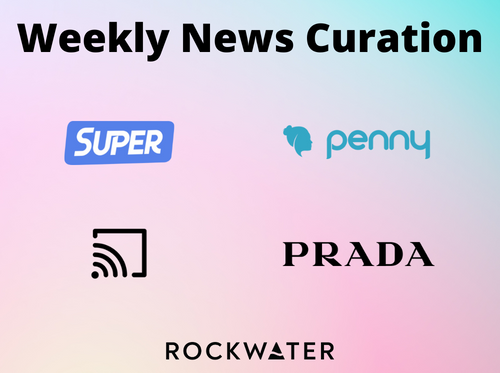Creator Economy’s SAAS Winter, buywith Raises $9.5M, and 5 Keys to Web3 Survival
What We’re Reading
3 articles + RockWater analysis to make you a better investor and operator.
———
Livestream Shopping Platform ‘buywith’ Closes $9.5 million Seed Round
CTECH, 5.25.22
- It’s the 2nd big fundraise news in livestream shopping last week, following Firework’s announced $150 million raise.
- Founded in 2018, buywith has offices in Tel Aviv, recently registered an entity in the US, and is opening offices in the UK to expand in Europe.
- Funds will be used to grow sales, marketing, and R&D teams across the globe, focusing on North America.
- The round was led by igniteXL Ventures, a Silicon Valley-based global fund with a special focus on technology-driven beauty and wellness investments.
- Other investors include Fab Co-Creation Studio Ventures, founded by former CEO of Lancome, Alibaba.com’s former President of North America and Europe, Alibaba.com GM of North America, Regah Ventures, Irani CVC, the venture arm of Factory54 and a luxury retailer in Israel, and True Global, the UK-based e-commerce and retail fund.
—
The RockWater Take by Chris Erwin
We tracked a lot of capital flows to “destination” platforms in livestream commerce over the past year e.g. to Whatnot, NTWRK, Popshop Live, more (our deal tracker is linked here).
But based on the Firework and buywith announcements last week, it’s clear investors are increasingly valuing tech businesses that empower shoppable livestreams on existing brand and retailer sites. A growing new direction for livestream commerce capital.
Why?
Cause investors follow the $$. And per the article:
“…the buywith platform has delivered an 8X increase in eCommerce conversions, an increase of around 40% session engagement rate, and an average 10x ROI.”
And when you bolt that onto a company platform with a large product portfolio AND lots of existing customer traffic like that of Walmart.com and Nordstrom.com, the mutual win for retailer and tech provider can be quite large! Particularly when you have a business model that includes recurring SAAS revenue + GMV participation (dependent on partner deal structures). Further, UA for new platforms is getting more expensive by the day due to (1) an increasingly crowded e-commerce environment, and (2) challenges in attributuion due to ATT, loss of the cookie, and privacy regulation.
This bodes well for other integrated solution providers (described here) like Stage TEN, LiveLike, Bambuser, and more.
———
How Startups Can Survive the Creator Economy Winter
Napkin Math, 5.19.22
The RockWater Take by Michael Booth
Depending on how you differentiate between social media users and creators, the TAM of the creator economy is anywhere from 50-200 million users.
Currently, there is winner-take-all distribution of outcomes in the creator economy. A burgeoning middle class of creators is aspirational, but does not yet exist at meaningful scale. Some data points to support:
From Twitch’s leaked creator earnings:
- 50% of revenue was made by the top 1% of streamers.
- 75% of accounts that earn revenue made less than $120.
- Only 0.06% received over the US median household income of $67,521.
- A quarter of all revenue was earned by the top 1,000 accounts.
LinkTree released a survey last month which found only 12% of FT creators make >$50k per yr, whereas 46% make less than $1,000 per year. The severity of the delta between Creator Economy “haves” and “have-nots” has clear implications on biz model viability.
Many of the unicorns in The Information’s Creator Economy database are SAAS companies. Yet, with the Creator Economy’s VERY high Gini coefficient, SAAS companies need to price at consumer levels (not enterprise) to capture meaningful market share. Using a mid point estimate of a 150 million creator TAM, if we take 12% of that pool (those who make over $50k per yr) we come up with a SAM of 18 million creators.
Say a Creator Economy SAAS company charges $10 per month ($120 per year) and is able to capture 20% of the SAM at scale (equivalent to Salesforce market share in CRM). That brings their projected ARR to $432 million, assuming no churn. At an 8x ARR multiple (new normal for high growth SAAS company in a down market) that pegs a valuation around $3.5 billion. To be clear, those are very favorable assumptions that would require great operators with A+ execution. And even under those conditions, Creator Economy SAAS companies are barely scraping unicorn territory at maturity.
All this is to say, as VCs are tighten their screws I suspect Creator Economy SAAS will be hit disproportionately hard, as the market size isn’t there yet to justify unicorn valuations for but just perhaps a select few companies. And with how hyper-focused VCs are with finding the next unicorn, I suspect newer Creator SAAS companies will have a very difficult time raising their initial rounds to get off the ground. The fix for Creator Economy operators is to shift from a SAAS model to a revenue share model, which both increases SAM and customer capture rate.
More on this in a future blog post…
———
Five Ways Web3 Companies Will Have to Adapt to Survive
The Information, 5.27.22
- Survival won’t be easy, but the companies that do the hard work of adapting to new market conditions will be well positioned to thrive when the thaw comes.
- Web3 projects need to evolve into revenue-oriented businesses.
- Regulation is inevitable and must be managed—or avoided.
- Web3 businesses need to learn sophisticated marketing math.
- Web3 needs more traffic on the boardwalk.
—
The RockWater Take by Alex Zirin
As catastrophic wealth-destruction and digital property theft continue to dominate crypto headlines, investor panic is being labeled as a ‘return to fundamentals’. In reality, the same momentum that drove astronomical valuations across Web3 (namely, a $250 billion combined market cap across DeFi) fueled May’s overcorrection. As usual, the truth lies somewhere in the middle.
As with all recessionary periods, those who survive will be champions. The key will be just that, survival. Of the five ‘Keys to Survival’ listed above, No’s 3 and 5 are especially salient.
3. The embrace of regulation will be critical to the success of US-based Web3 orgs. If operators and investors don’t know where the lines are, how are they supposed to color within them? Our take is that some regulation here is a very good thing, and we don’t agree that it should be avoided. Additionally, regulation will bring some much needed legitimacy and sense-of-security to the crypto landscape.
5. Frankly, the town square is still too empty. Filled mostly by tech enthusiasts and retail investors looking to make a quick return, Web3 is nowhere near the omnipresence that it promises. The key here: the development of tools that keep on-chain components invisible. When the value of on-chain applications outweighs the resistance to change, the masses will adopt. In the meantime, friction simply remains far too high.
———
If these insights are relevant to projects you are thinking through, ping us here. We’re always excited to riff through ideas!



